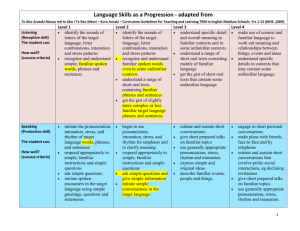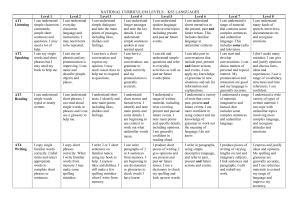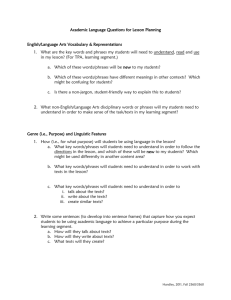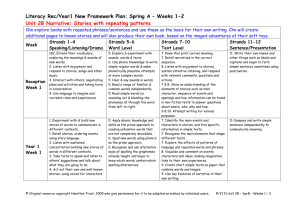progressions by skill mode level version 2
advertisement
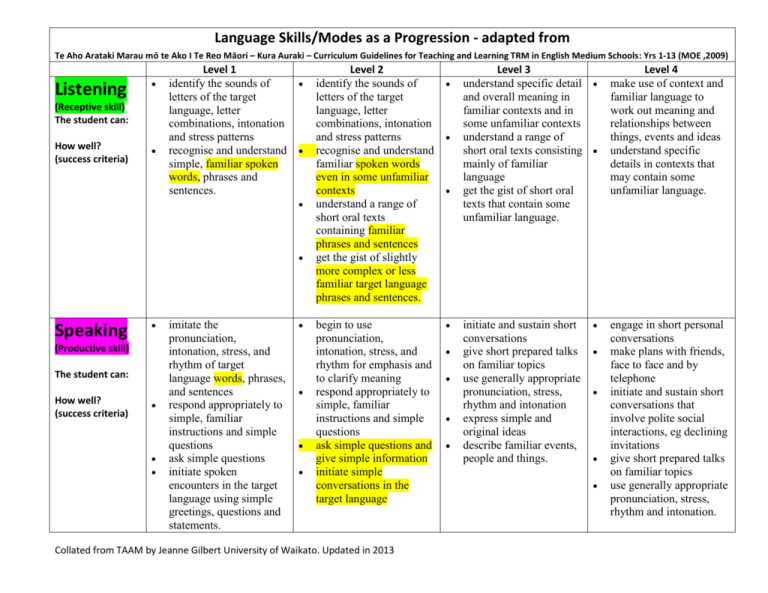
Language Skills/Modes as a Progression - adapted from Te Aho Arataki Marau mō te Ako I Te Reo Māori – Kura Auraki – Curriculum Guidelines for Teaching and Learning TRM in English Medium Schools: Yrs 1-13 (MOE ,2009) Listening (Receptive skill) The student can: How well? (success criteria) Level 1 identify the sounds of letters of the target language, letter combinations, intonation and stress patterns recognise and understand simple, familiar spoken words, phrases and sentences. Speaking (Productive skill) The student can: How well? (success criteria) imitate the pronunciation, intonation, stress, and rhythm of target language words, phrases, and sentences respond appropriately to simple, familiar instructions and simple questions ask simple questions initiate spoken encounters in the target language using simple greetings, questions and statements. Level 2 identify the sounds of letters of the target language, letter combinations, intonation and stress patterns recognise and understand familiar spoken words even in some unfamiliar contexts understand a range of short oral texts containing familiar phrases and sentences get the gist of slightly more complex or less familiar target language phrases and sentences. begin to use pronunciation, intonation, stress, and rhythm for emphasis and to clarify meaning respond appropriately to simple, familiar instructions and simple questions ask simple questions and give simple information initiate simple conversations in the target language Collated from TAAM by Jeanne Gilbert University of Waikato. Updated in 2013 Level 3 understand specific detail and overall meaning in familiar contexts and in some unfamiliar contexts understand a range of short oral texts consisting mainly of familiar language get the gist of short oral texts that contain some unfamiliar language. initiate and sustain short conversations give short prepared talks on familiar topics use generally appropriate pronunciation, stress, rhythm and intonation express simple and original ideas describe familiar events, people and things. Level 4 make use of context and familiar language to work out meaning and relationships between things, events and ideas understand specific details in contexts that may contain some unfamiliar language. engage in short personal conversations make plans with friends, face to face and by telephone initiate and sustain short conversations that involve polite social interactions, eg declining invitations give short prepared talks on familiar topics use generally appropriate pronunciation, stress, rhythm and intonation. Reading (Receptive skill) The student can: How well? (success criteria) Level 1 identify letters of the target language, letter combinations, basic written language conventions and simple punctuation recognise and understand simple, familiar written words, phrases and sentences. Writing (Productive skill) The student can: How well? (success criteria) write letters and numbers write vowels with accents reproduce letter combinations and punctuation for target language words, phrases and sentences in familiar contexts write simple, familiar words, phrases and sentences using the conventions of written language, such as appropriate spelling and punctuation. Level 2 identify letters of the target language, letter combinations and simple punctuation recognise and understand simple, familiar written words, phrases and sentences understand short written texts consisting of familiar target language words, phrases and sentences get the gist of slightly more complex or less familiar target language phrases and sentences. write simple, familiar words, phrases, and sentences using spelling and punctuation conventions write simple messages in the target language write a series of sentences in the target language describing the appearance or characteristics of something. Collated from TAAM by Jeanne Gilbert University of Waikato. Updated in 2013 Level 3 understand specific detail and overall meaning in a range of short written texts consisting mainly of familiar language get the gist of short written texts that contain some unfamiliar language. use resources, eg dictionaries and glossaries to experiment with some new language in writing and to check spelling prepare and write short texts on familiar topics write simple personal letters and emails use appropriate writing conventions Level 4 understand a range of short written texts that consist mainly of familiar language understand overall meaning and specific detail in contexts that may contain some unfamiliar language guess the meanings of unfamiliar words and phrases used in familiar contexts. use resources, eg dictionaries and glossaries to experiment with new language and to review writing for accuracy write short texts on familiar topics plan longer written texts and write parts of these use appropriate writing conventions send text and email messages Viewing (Receptive skill) The student can: How well? (success criteria) Presenting (Productive skill) The student can: How well? (success criteria) Level 1 recognise the communicative significance of body language interpret meanings that are conveyed in combinations of words and images or symbols. use appropriate body language and images to convey messages (with and without accompanying verbal language) use selected features of visual language to add meaning to simple written or oral text. Level 2 respond appropriately to meanings conveyed through selected visual texts ; understand and respond to combinations of visual and verbal language in selected texts. produce visual texts to present information and/or ideas combine visual and verbal language to present information and/or ideas. Collated from TAAM by Jeanne Gilbert University of Waikato. Updated in 2013 Level 3 identify and respond to some visual and verbal features of texts and the ways these features interact for particular purposes understand and respond to a range of features in selected visual texts. present texts in which visual and verbal features interact to produce particular meanings and effects present or perform a oral task or song making effective use of visual language features. Level 4 identify particular features of visual language and understand their significance in communicating information and ideas to specific audiences understand and respond to combinations of visual and verbal language and their significance in communicating information and ideas to specific audiences. communicate information, ideas, or narrative through texts in which visual and verbal features interact to produce particular meaning and effects present or perform traditional or modern cultural items in selected settings.


